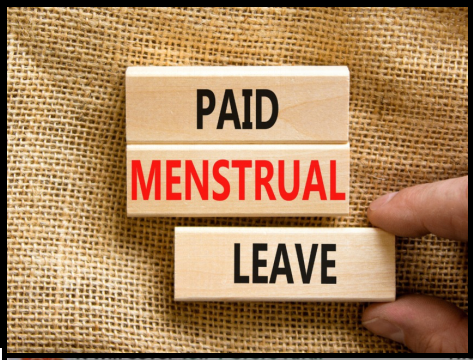“PROMOTING MENSTRUAL LEAVE: A STEP TOWARDS GENDER EQUALITY”
Syllabus:
- GS-2-Health and wellbeing ,Women issues and solutions
Focus:
- The article explores global efforts for menstrual equity, highlighting tax-free initiatives and challenges in India.
- The article explores the legislative efforts, international examples, and policy challenges related to the implementation of menstrual leave in India.
- It highlights the role of political parties in promoting women’s rights and gender equality through initiatives such as menstrual leave, emphasizing the need for greater gender sensitivity and social change.
Source-TH
Introduction
- Elections as a catalyst for addressing gender biases.
- DMK’s promise of menstrual leave in Tamil Nadu’s 2024 election manifesto.
- “DMK will insist that the Union government enact a law providing menstrual leave to women, emphasizing the journey towards gender equality.”
Legislative Efforts for Menstrual Leave
- Private Member Bills introduced by S. Jothimani, Ninong Ering, Shashi Tharoor, and Hibi Eden.
- ‘Right to Menstrual Hygiene and Paid Leave Bill, 2019’,which sought to bring menstrual leave into the ambit of the rights of a woman, and a refusal of such leave into the domain of The Sexual Harassment of Women at Workplace (Prevention, Prohibition and Redressal) Act, 2013
- Supreme Court’s stance on menstrual leave-The Supreme Court of India, early in 2023, refused to entertain a public interest litigation in Shailendra Mani Tripathi vs Union of India which sought direction to the state on menstrual leave; it was of the opinion that it is in the policy domain of the government
- Central government’s refusal to enact a policy on menstrual leave.
Progressive Initiatives in Indian States
- Historical precedence in Kerala.For instance, the Kerala Sahitya Academy published work, Kerala in 19th Century, mentions that Kerala was the first (in then Cochin State) to recognise the need for “ period leave” for students and allowed it during examinations in 1912.
- The need for other states to take similar actions.
| IMPORTANT POINTS :
· According to the most recent National Family Health Survey (NFHS)-5 report, almost 50% of Indian women between the ages of 15 and 24 still rely on using fabric to shield themselves during their periods. · Three days of paid vacation during menstruation were stipulated for women and transwomen in the 2022 “Right of Women to Menstrual Leave and Free Access to Menstrual Health Products Bill.” Additional advantages for students are still pending in the Act. There are now only two states that allow women to take menstrual leave: Kerala and Bihar. |
International Examples of Menstrual Leave
- Adoption of menstrual leave in Asian countries like Japan, Indonesia, South Korea, Taiwan, and Vietnam.
- Limited progress in the Western world, with exceptions like Sweden and Spain.
- In the UK,the majority of companies (as well as schools, etc.) could readily offer free “emergency” period supplies (such as tampons and pads), ibuprofen (an anti-inflammatory drug), heated pads or hot water bottles, hot beverages,
- Endorsement of menstrual leave by international organizations like the ILO and WHO.
Policy Gaps and Challenges
- Exclusion of menstrual leave from India’s Social Security Code, 2020.
- Impact on women laborers in agriculture and other sectors.
- Comparison with progressive measures taken by gig worker platforms like Swiggy and Zomato.
Gender Sensitivity and Social Change
- Policy solutions to address gender inequalities.
- Breaking taboosand promoting gender-sensitive discussions.
- Importance of political recognition in promoting women’s rights and gender equality.
| About Period Poverty :
Period poverty is the inability of those with low earnings to obtain or purchase appropriate period goods. India’s steps– · SABLA program: The Ministry of Women and Child Development oversaw its implementation. Its main topics include diet, health, cleanliness, and sexual and reproductive health (with a connection to rural mothers and daycare facilities). · The National Rural Livelihood Mission- helps small businesses and self-help organizations make sanitary pads. · Swachh Bharat: Swachh Vidyalaya (SB:SV) and the Swachh Bharat Mission: · Guidelines for Sanitation’s Gender Issues, 2017: The Ministry of Drinking Water and Sanitation has developed these to guarantee gender parity and the empowerment of women and girls in terms of sanitation. · The National Guidelines for the Management of Menstrual Hygiene: · Pradhan Mantri Bhartiya Janaushadhi Pariyojana (2019): Offers low-cost sanitary napkins, but distribution challenges persist, especially in rural areas. |
Conclusion
- Recap of the significance of menstrual leave inpromoting gender equality.
- Call to action for policymakers and political parties to prioritize menstrual leave policies.
Source:The Hindu
Mains Practice Question :
GS-3
“Discuss the legislative efforts, international examples, and policy challenges surrounding the implementation of menstrual leave in India. Evaluate the role of political parties in promoting women’s rights and gender equality through initiatives such as menstrual leave.” (250 words)




